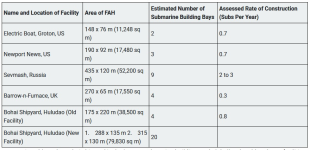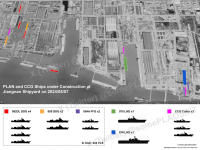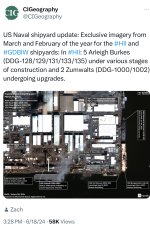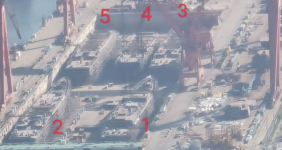Beijingwalker
Elite Member
- Nov 4, 2011
- 76,533
- 104,134
- Country of Origin

- Country of Residence

'Turn Out Warships Like Sausages': China Has the Largest Navy on Earth
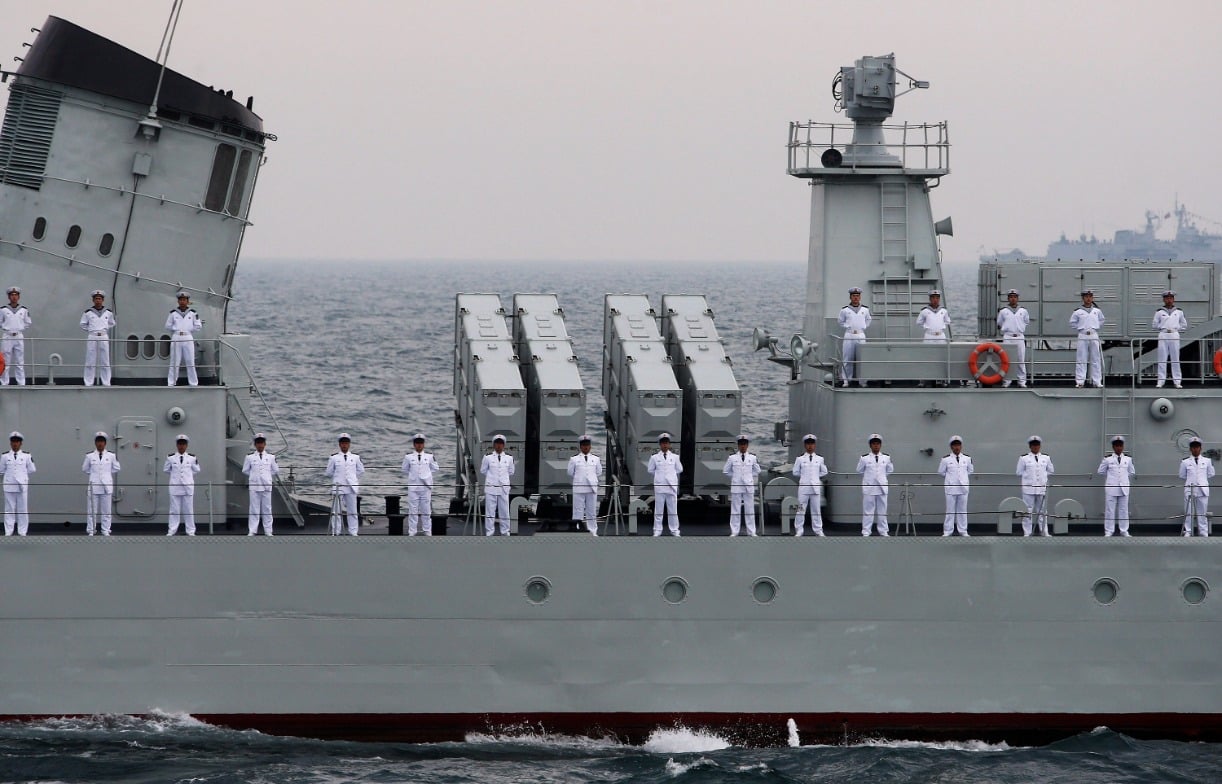
China's People’s Liberation Army Navy (PLAN) has surpassed the U.S. Navy in size, posing a significant strategic challenge. Critics argue that China inflates its fleet size by including dual-use vessels like civilian Roll-On-Roll-Off ferries, but this flexibility enhances China's naval capability.
by Brandon J. Weichert
Summary and Key Points You Need to Know: China's People’s Liberation Army Navy (PLAN) has surpassed the U.S. Navy in size, posing a significant strategic challenge. Critics argue that China inflates its fleet size by including dual-use vessels like civilian Roll-On-Roll-Off ferries, but this flexibility enhances China's naval capability.
-Unlike the U.S., which once relied on industrial capacity to outproduce enemies, decades of deindustrialization have left America unable to match China’s rapid shipbuilding.
-China's naval technology is also advancing, with newer submarines nearing parity with American counterparts.
-Combined with Russia's support, China's growing navy is a crucial factor in global naval dominance.
Here’s Why China’s Navy Being Bigger Than the US Navy is Important
The United States Navy has been the strongest navy in the world since the end of the Second World War. Even during the Cold War, when America was challenged by a rival superpower, the Soviet Union, the US Navy remained the dominant force on the High Seas.It was not only that the US Navy was more competent than its rivals. It was also that the American Navy was bigger than the fleets its enemies could muster.
Today, that has changed. Possibly forever.
The world’s largest navy (in numerical terms) is the People’s Liberation Army Navy (PLAN), with the Americans coming a distant second. Many caveats are often thrown at the Chinese PLAN.
For example, critics say that China includes ships as part of their navy that the Americans do not for a variety of reasons.
Quantity Does Have a Quality of Its Own
Indeed, as Mao is rumored to have once said, “quantity has a quality of its own.” China fights dirty from the American perspective. And why wouldn’t they? They’re the ones trying to overthrow the established order. Insurgents always fight unfairly. For China, then, they’ve little compunction about manipulating the definition of warship. One thing they love to do in China is to create what’s known as “dual-use” technologies.These are systems that are designed for obvious civilian uses in peacetime that, in wartime, can easily be converted into weapons of war.
The Americans during their revolution, and throughout much of the nineteenth century, regularly amplified their limited naval power (when compared to the mighty European empires of that era) by relying upon a fleet of merchant vessels that could be quickly converted into warships (this was the basis of the privateers in America’s history).
China’s Navy, we are told, is not yet ready to invade Taiwan because they lack adequate numbers of amphibious assault warships. This is true, if one is only looking at military amphibious capabilities in the PLAN. When one looks at China’s civilian Roll-On-Roll-Off (RoRo) ferry capability (all of which have been built to military specifications), China already has the world’s largest amphibious landing capacity.
So, the claim that China cooks its books to make it look bigger than it really is, only partly passes the smell test.
And, as for quantity trumping quality, think back to how the Soviets beat the Nazis on the Eastern Front of World War II. They ultimately were able to mass far greater numbers of troops and equipment than the Wehrmacht could withstand. That, and the fact that the Russians were fighting on their home turf (at least initially), gave them advantages.
More aptly, perhaps, it would be wise to look at how the US Navy overcame the Imperial Japanese Navy (IJN) in World War II. Very simply, the Americans had latent industrial capacity. Once the war got going for the Americans, they began churning out all manner of warships in record time.
The American industrial capacity was so much greater than those of Japan that, in the long run, the Japanese could not both sustain the losses of the War of the Pacific and replace those losses in any timely or meaningful way.
How America’s Deindustrialization Impacts the Naval Race with China
Sadly, after decades of deindustrialization, the Americans cannot any longer rely on latent industrial capacities to stimulate a war winning effort, should conflict erupt between the United States and the People’s Republic of China.It is the Chinese who have become the primary beneficiaries of America’s decades-long quixotic move to amplify short-term, quarterly profits by sending all the decent manufacturing jobs and technologies overseas (notably, at least for a long time, to China).
China can today churn out warships (and other weapons of war) like sausages.
Another argument is that, while China’s navy is larger than that of the United States, it is not as technically superior.
Even that claim does not ring true.
Again, think back to the American experience in WWII. Quantity more than made up for whatever quality the US Navy may have lacked when compared to Japan’s Navy at the start of the war (Japan first innovated the use of aircraft carriers as demonstrated by their victory over the Americans at Pearl Harbor).
Over time, however, the Americans not only created many more warships than could the Japanese, but the US Navy systems got better with each iteration. And the more that the Navy produced these systems, the quicker and better they learned how to perfect the next generation.
American shipyards today cannot handle the Navy’s peacetime demands. They certainly could not handle wartime conditions. China, however, can. Further, all China needs to do is create enough warships to overwhelm the Americans in waters closer to Chinese territory than to America to give Beijing the victory at sea it seeks over Washington.
One last thing.
China is Advanced
Take a gander at how China has innovated their naval technology. Today, their newest submarines are more sophisticated and at parity with their American rivals than even a generation ago. Meanwhile, Chinese scientists are innovating new propulsion systems for their subs, such as using lasers as extremely fast underwater propulsion.Oh, and neighbor Russia, probably the world’s second-most powerful submarine force (beside the American force), has now taken a strategy for sharing advanced submarine technologies with their newfound partners in Beijing.
All these developments, coupled with China’s massive manufacturing supremacy, means that the size of China’s Navy is hugely important.





